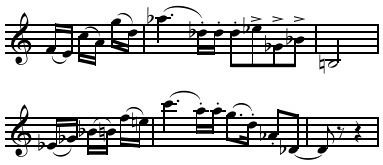 | ||
The Lyric Suite is a six-movement work for string quartet written by Alban Berg between 1925 and 1926 using methods derived from Arnold Schoenberg's twelve-tone technique. Though publicly dedicated to Alexander von Zemlinsky (from whose Lyric Symphony it quotes), the work has been shown to possess a "secret dedication" and to outline a "secret programme" (Perle 1977a,). Berg arranged three of the "pieces" (movements) for string orchestra in 1928.
Contents
- Composition and analysis
- Movements
- Constructive rhythm
- Version for string orchestra
- Recordings
- References
The title "Lyric Suite" also refers to a series of about 600 ink-on-rice-paper drawings created by Robert Motherwell in 1965. The drawings were given this title as a result of Motherwell having listened to a recording of the string quartet repeatedly while working on the drawings.
Composition and analysis
As Berg's friend and fellow Schoenberg pupil Erwin Stein wrote in the preface to the score, "The work (Ist and VIth part, the main part of the IIIrd and the middle section of the Vth) has been mostly written strictly in accordance with Schoenberg's technique of the 'Composition with 12 inwardly related tones." A set of 12 different tones gives the rough material of the composition, and the portions which have been treated more freely still adhere more or less to the technique" (Perle 1990, 123). Perle points out that the first movement is not strictly twelve-tone, with the opening four chords being derived not from the series but from the interval-7 cycle (Perle 1977a, 21).
According to René Leibowitz, the first movement is "entirely written in the twelve-tone technique, [it] is a sonata movement without the development. Thus the recapitulation follows directly upon the exposition; but, because of the highly advanced twelve-tone technique of variation, everything in this movement is developmental" (Leibowitz 1947,). The first analysis was undertaken by H. F. Redlich, who notices that "the first movement of the Lyric Suite develops out of the disorder of intervals in its first bar, the notes of which, strung out horizontally, present the complete chromatic scale, and from this in the second and following bars, grows the Basic Set in its thematic shape" (Redlich 1957,).
Theodor W. Adorno called the quartet "a latent opera" (Sandberger 1996). Redlich (1957, 142) described "the concealed vocality of the Lyric Suite," despite having no knowledge of the setting of Baudelaire's De profundis clamavi in the finale movement, deciphered by Douglass M. Green (1976) from what George Perle calls "Berg's cryptic notations". Perle discovered a complete copy of the first edition annotated by Berg for his dedicatee, Hanna Fuchs-Robettin (Franz Werfel's sister, with whom Berg had an affair in the 1920s), later that year (Perle 1990,).
Berg used the signature motif, A-B♭-H-F, to combine Alban Berg (A. B.) and Hanna Fuchs-Robettin (H. F.) (Reel 2010). This is most prominent in the third movement. Berg also quotes a melody from Zemlinsky's Lyric Symphony in movement four which originally set the words "You are mine own". In the last movement, according to Berg's self-analysis, the, "entire material, the tonal element too ... as well as the Tristan motif" is developed "by strict adherence to the 12-note series" (Sandberger 1996).
The outer sections of the Allegro misterioso present the same music forwards and then backwards, while the Trio ecstatico, the B section of the ABA, is through-composed (Pople 1991, 17–18). Berg generates a characteristic rhythmic cell through partitioning the series into a seven note chromatic segment and a complementary five-note motive from the remaining notes (Pople 1991, 15). See below.
Despite assertions by Berg and others, George Perle, however, "had not yet been informed, as Leibowitz and Redlich were by the time they came to write their respective books, that everything in the 'strictly' dodecaphonic first movement had to be derived from a single serial ordering of the twelve notes of the chromatic scale." Rather, he, "recognized that the first three chords unfold tetrachordal segments of a single statement of the cycle of fifths (C7), and that at the bottom of the same page, in bars 7–9, the cello presents a linear statement of the same cycle." The second violin unfolds "the initial tetrachordal segmentation of the perfect-5th cycle," again at the beginning of the recapitulation. He asks: "How could one [think] of the initial bar as 'disordered'? If anything is to be designated as an Urform here, surely it is this perfect-5th cycle, given its background role in relation to the tone row and other components of the movement."
The "Row" of the Lyric Suite is an all-interval row. It is the first all-interval row derived by its discoverer and Berg student Fritz Heinrich Klein (Whittall 2008, 68).
Movements
- Allegretto gioviale
- Andante amoroso
- Allegro misterioso – Trio estatico
- Adagio appassionato
- Presto delirando – Tenebroso
- Largo desolato
Constructive rhythm
Mov. III tone row partitioned into a rising chromatic segment and remaining pitches:
(Stroh 1968, 26; Perle 1990,.Version for string orchestra
Berg in 1928 arranged the second, third and fourth movements of the Lyric Suite for string orchestra. According to Adorno (1991, 105):
If the lyrical nature of the Suite is best fostered in the quartet, its dramatic nature is best fostered in the string tutti; only here are its contours dissolved as completely and enigmatically as the accompanimental concept of the sound demands; and only here does the paroxysm attain its full catastrophic force.
Theo Verbey arranged the remaining movements in 2006. The first recording of the complete suite in the string orchestra version was made in 2014 by Ensemble Resonanz.
Recordings
The piece has been recorded by and released on:
